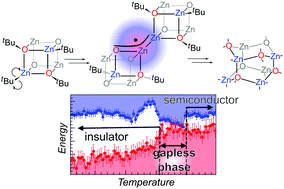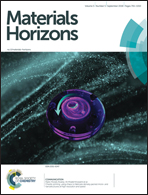Hidden gapless states during thermal transformations of preorganized zinc alkoxides to zinc oxide nanocrystals†
Abstract
Zinc oxide (ZnO) is one of the most versatile semiconductor materials with multifarious potential applications. Easily accessible alkylzinc alkoxides have been widely exploited as single-source precursors of ZnO-based nanomaterials but their multi-step decomposition pathways have not been understood in detail. Herein, the formation mechanism of ZnO nanocrystals via solid-state thermal decomposition of a model pre-organised alkylzinc alkoxide precursor, i.e. [tBuZn(μ3-OtBu)]4, is elucidated using in situ valence-to-core X-ray emission (v2c-XES) and high energy resolution off-resonant spectroscopy (HEROS) in conjunction with theoretical calculations. Combination of in situ spectroscopic measurements and theoretical simulations indicates that the precursor structural evolution is initiated by the homolytic cleavage of the R–Zn bond, which leads to the formation of a transient radical ([˙Zn(μ3-OR)][RZn(μ3-OR)]3) species, which is responsible for the initial decomposition process. The ensuing multistep transformations involve the formation of intermediate radical zinc oxo-alkoxide clusters with gapless electronic states. Hitherto, the formation of clusters of this type has not been considered either as intermediate structures en route to a semiconductor ZnO phase or as potential species accounting for various defect states of ZnO NCs, particularly the singly charged oxygen vacancy, Vo+.



 Please wait while we load your content...
Please wait while we load your content...